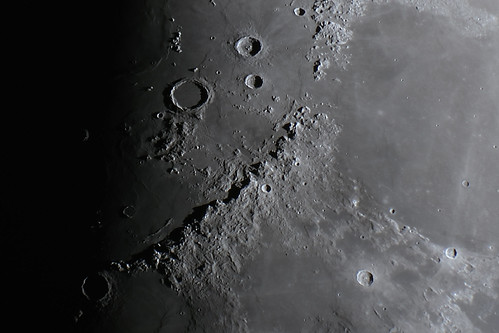26 August 2019, 22:00 – 23:30 BST
After the success of the previous night’s imaging session, it seemed only fair that I should photograph the other (eastern) half of the Veil Nebula, though without the benefit of a naked eye star (52 Cyg) to use as a target it took a little longer to get it centred.
Conditions: another warm night, slight haze affecting the transparency.
M71, globular cluster, Sagitta
Rich, filmy mass of stars in an already rich section of the Milky Way. More condensed than M11, but lacking the density of more typical globulars.
Albireo, Cygnus
Lovely double star; golden primary, pale blue secondary. (There isn’t really anything new I can say about Albireo, but I keep coming back to it.)
NGC 6819, open cluster, Cygnus
Cluster with a hat-shaped outline. Member stars not particularly bright. Central gap. Resides in a rich Milky Way field.
NGC 6866, open cluster, Cygnus
Another Cygnus cluster - like a larger, looser version of 6819.
Veil Nebula, supernova remnant, Cygnus
A comparison (at 50x) of the Ultrablock and the OIII filter. While both filters do an excellent job on this nebula, it was clear that the OIII provided a much darker background, thus making the nebula itself seem brighter. This also made it easier to see the overall shape of the two arcs and some of their internal structure, as well as the much fainter Pickering/Fleming’s Triangle. When I switched back to the Ultrablock, the triangle was just about visible, but I probably wouldn’t have noticed it if I hadn’t already seen it with the OIII.
Another thing I noticed with the OIII was that the area inside the loop seemed brighter than outside (particularly on the eastern side). This might be an illusion (long exposure images show that the visible nebulosity is confined to discrete sections), but the photos I took seem to hint at a greater star density inside the Veil. (Is the shockwave clearing away the interstellar medium, creating a window in that part of the Milky Way?)
NGC 7662, The Blue Snowball, Andromeda
Tough to find on this occasion for some reason. Otherwise as before, blue-green colour.
NGC 7331, spiral galaxy, Andromeda
Streak of light, no sign of the companion galaxies (the “fleas”), but not surprising given the less than optimal transparency.
NGC 281, emission nebula, Cassiopeia
I needed the OIII filter to see it (at 50x), but once I did the overall comma shape stood out well, with a suggestion of dark inlets cutting into the nebula.
NGC 7635, Bubble Nebula, Cassiopeia
With the OIII filter still in place, I pushed the telescope past M52, not really expecting to see anything, but the nebula stood out surprisingly well. Not so much a bubble as a little crescent-moon shaped patch of nebulosity. I swapped out the 24mm Panoptic for the 9mm Nagler (minus the filter), but the nebula was no longer visible.
I rounded off the evening with a quick look at two old favourites in Cassiopeia: M52 (a rich little cluster) and NGC 7789 (a rich large cluster with faint stars arranged in clumps).
Nature note
While I was taking a test shot of the Veil I heard a “clonk” from the XT10. Upon investigating with a red-light torch, I discovered that a large pale frog had hopped onto the base underneath the main mirror. It took some persuading to vacate its temporary home, but I eventually sent it safely on its way. Still, at least it blundered into that scope rather than the one taking long exposures.



